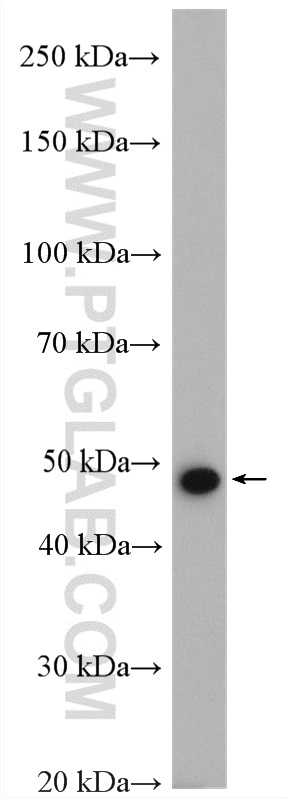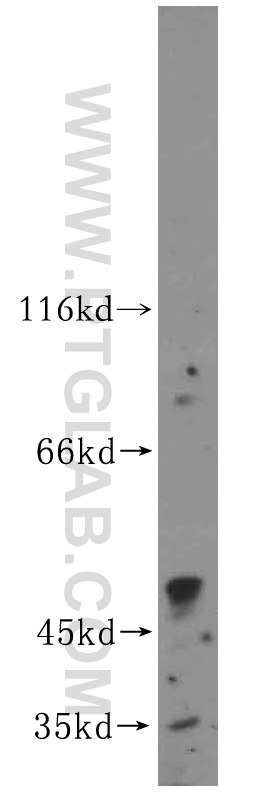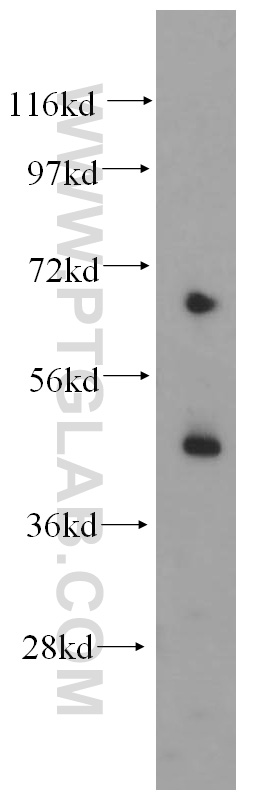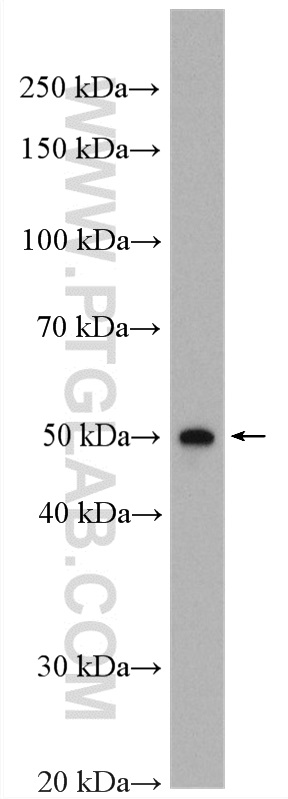验证数据展示
经过测试的应用
| Positive WB detected in | rat heart tissue, HepG2 cells, human heart tissue, rat skeletal muscle tissue |
推荐稀释比
| 应用 | 推荐稀释比 |
|---|---|
| Western Blot (WB) | WB : 1:200-1:1000 |
| It is recommended that this reagent should be titrated in each testing system to obtain optimal results. | |
| Sample-dependent, Check data in validation data gallery. | |
发表文章中的应用
| WB | See 2 publications below |
产品信息
16920-1-AP targets Kir6.2 in WB, ELISA applications and shows reactivity with human, mouse, rat samples.
| 经测试应用 | WB, ELISA Application Description |
| 文献引用应用 | WB |
| 经测试反应性 | human, mouse, rat |
| 文献引用反应性 | mouse, rat |
| 免疫原 | Kir6.2 fusion protein Ag10262 种属同源性预测 |
| 宿主/亚型 | Rabbit / IgG |
| 抗体类别 | Polyclonal |
| 产品类型 | Antibody |
| 全称 | potassium inwardly-rectifying channel, subfamily J, member 11 |
| 别名 | BIR, HHF2, IKATP, KCNJ11, KIR6.2, PHHI, TNDM3 |
| 计算分子量 | 390 aa, 44 kDa |
| 观测分子量 | 48 kDa |
| GenBank蛋白编号 | BC064497 |
| 基因名称 | Kir6.2 |
| Gene ID (NCBI) | 3767 |
| RRID | AB_2130461 |
| 偶联类型 | Unconjugated |
| 形式 | Liquid |
| 纯化方式 | Antigen affinity purification |
| UNIPROT ID | Q14654 |
| 储存缓冲液 | PBS with 0.02% sodium azide and 50% glycerol , pH 7.3 |
| 储存条件 | Store at -20°C. Stable for one year after shipment. Aliquoting is unnecessary for -20oC storage. |
背景介绍
Kir6.2 (also known as BIR or IKATP), encoded by the KCNJ11 gene, is the pore-forming unit of the ATP-sensitive K+ channel, an inward-rectifier potassium ion channel. Kir6.2 is controlled by G-proteins and is found associated with the sulfonylurea receptor (SUR) to constitute the ATP-sensitive K+ channel. The KCNJ11 gene is located at 11p15.1 and has no intron. Mutations in KCNJ11 are a cause of familial PHHI, an autosomal recessive disorder characterized by unregulated ins secretion. Defects in KCNJ11 may also contribute to autosomal dominant non-ins-dependent diabetes mellitus type II (NIDDM), transient neonatal diabetes mellitus type 3 (TNDM3), and permanent neonatal diabetes mellitus (PNDM).
实验方案
| Product Specific Protocols | |
|---|---|
| WB protocol for Kir6.2 antibody 16920-1-AP | Download protocol |
| Standard Protocols | |
|---|---|
| Click here to view our Standard Protocols |
发表文章
| Species | Application | Title |
|---|---|---|
Life Sci KATP channels as ROS-dependent modulator of neurotransmitter release at the neuromuscular junctions | ||
Sci Rep Glucocorticoid receptor-NECAB1 axis can negatively regulate insulin secretion in pancreatic β-cells | ||
Int Immunopharmacol Nicorandil restores endothelial cell Kir6.2 expression to alleviate neuropathic pain in mice after chronic constriction injury |



